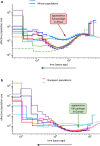Population size does not explain past changes in cultural complexity
- PMID: 27044082
- PMCID: PMC4843435
- DOI: 10.1073/pnas.1520288113
Population size does not explain past changes in cultural complexity
Abstract
Demography is increasingly being invoked to account for features of the archaeological record, such as the technological conservatism of the Lower and Middle Pleistocene, the Middle to Upper Paleolithic transition, and cultural loss in Holocene Tasmania. Such explanations are commonly justified in relation to population dynamic models developed by Henrich [Henrich J (2004)Am Antiq69:197-214] and Powell et al. [Powell A, et al. (2009)Science324(5932):1298-1301], which appear to demonstrate that population size is the crucial determinant of cultural complexity. Here, we show that these models fail in two important respects. First, they only support a relationship between demography and culture in implausible conditions. Second, their predictions conflict with the available archaeological and ethnographic evidence. We conclude that new theoretical and empirical research is required to identify the factors that drove the changes in cultural complexity that are documented by the archaeological record.
Keywords: Tasmania; Upper Paleolithic transition; cultural complexity; cultural evolution; demography.
Conflict of interest statement
The authors declare no conflict of interest.
Figures







Comment in
-
Understanding cumulative cultural evolution.Proc Natl Acad Sci U S A. 2016 Nov 1;113(44):E6724-E6725. doi: 10.1073/pnas.1610005113. Epub 2016 Oct 25. Proc Natl Acad Sci U S A. 2016. PMID: 27791123 Free PMC article. No abstract available.
-
Reply to Henrich et al.: The Tasmanian effect and other red herrings.Proc Natl Acad Sci U S A. 2016 Nov 1;113(44):E6726-E6727. doi: 10.1073/pnas.1613074113. Epub 2016 Oct 25. Proc Natl Acad Sci U S A. 2016. PMID: 27791150 Free PMC article. No abstract available.
References
-
- Childe VG. Man Makes Himself. Watts; London: 1936.
-
- Binford LR. Post-Pleistocene adaptations. In: Binford SR, Binford LR, editors. New Perspectives in Archeology. Aldine; Chicago: 1968. pp. 313–341.
-
- Renfrew C. Before Civilisation. Knopf; New York: 1973.
-
- Earle TK. A model of subsistence change. In: Earle TK, Christenson AL, editors. Modeling Change in Prehistoric Subsistence Economies. Academic; New York: 1980. pp. 1–29.
-
- Redding RW. A general explanation of subsistence change: From hunting and gathering to food production. J Anthropol Archaeol. 1988;7(1):56–97.
Publication types
LinkOut - more resources
Full Text Sources
Other Literature Sources
Miscellaneous

